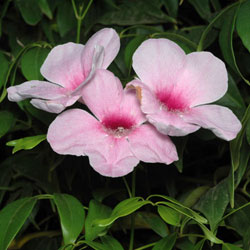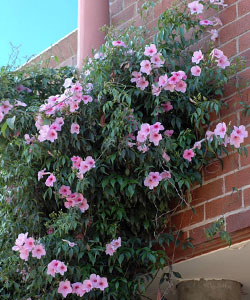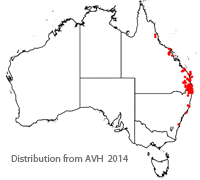Pandorea jasminoides
 |
 |
Bower of Beauty, Bower Vine, Bower Climber
Pandorea jasminoides (G.Don) K.Schum.
 Pandorea jasminoides, commonly known as Bower of Beauty, Bower Vine or Bower Climber is an evergreen, vigorous woody climber, and member of the Bignoniaceae family. Typically found in tropical and subtropical rainforests and warm temperate areas of eastern Queensland to northern New South Wales, it will thrive in southern Australia if provided sufficient moisture and frost protection when young. Despite being frost tender to 5˚C it survives Canberra winters in sheltered areas.
Pandorea jasminoides, commonly known as Bower of Beauty, Bower Vine or Bower Climber is an evergreen, vigorous woody climber, and member of the Bignoniaceae family. Typically found in tropical and subtropical rainforests and warm temperate areas of eastern Queensland to northern New South Wales, it will thrive in southern Australia if provided sufficient moisture and frost protection when young. Despite being frost tender to 5˚C it survives Canberra winters in sheltered areas.
Growing in most soils that are moist and well-drained (acidic soils are also suitable) it prefers full sun or part-shade. Adequate sunlight is required for good flowering and as a rainforest climber it will grow to reach for sunlight. Pandorea jasminoides tolerates a range of humidity conditions and due to growing well in inner urban areas it is assumed to be smog-tolerant.
The glossy dark green leaves are mostly opposite or in whorls of three and 12 to 20 cm long. Each leaf consists of 4 to 7 leaflets with lanceolate to ovate leaves. Flowers are white or pale pink trumpet-shaped with hairy centres, up to 6 cm long with lobes 2 to 3cm long, and they appear in clusters for months from late spring to summer. Flowers are followed by immature light green, oblong stalked fruit capsules that mature into woody pods about 8 cm long and 2 cm wide. The boat-shaped pods contain numerous papery seeds and when split reveal individual elongated or circular winged seeds.
Propagation is possible from fresh seed in spring and by stem cuttings or layering in summer. Young plants are very susceptible to frost damage and generally do not require fertiliser, although they respond well to light doses of slow-release and water soluble fertilisers. Once established it is rare for plants to require supplementary watering, unless located in hot areas with low rainfall.
While horticulturally desirable for its aesthetic appearance with year-long foliage and long-lasting floral displays, its vigorous growth is also an advantage for screening along fences or climbing on pergolas and trellises. It mixes well with natives and exotics and is very hardy in tropical to semi-tropical regions. Pruning after flowering can restrain growth and plants respond well to hard pruning.
It is important to note that Pandorea species develop a strong and penetrating root system and should not be planted near underground pipelines.
Text by Rosie Vatchenko (2014 Student Botanical Intern)
Name meaning: Pandorea jasminoidesPandorea – In Greek Mythology Pandora opened a sealed vessel to release evil spirits. In relation to the plant this refers to the many seeds released once the capsule is spilt open. jasminoides – From the Latin jasminum, meaning “jasmine” and the Greek oides, meaning “resembling”, referring to a resemblance to the genus Jasminum. |
References:
Australian Virtual Herbarium, Atlas of Living Australia (2014). Available at http://avh.ala.org.au/occurrences/search?taxa=pandorea+jasminoides#tab_mapView. [Viewed 26 January 2014.]
Australian Native Plant Society (2014). Pandorea jasminoides. Available at http://anpsa.org.au/p-jas.html. [Viewed 8 February 2014.]
Bailey, R. & Lake, J. (2001) Gardening with Australian rainforest plants, Bloomings Books, Melbourne, VIC.
Brickell, C. (1999) Gardeners encyclopaedia of plants and flowers, Dorling Kindersley Limited, London.
Elliot, W. R. & Jones, D. L. (1997) Encyclopaedia of Australian plants suitable for cultivation, Publishing Solutions, Singapore.
Greig, D. (1994) Australian climbers and ground covers, Simon & Schuster, East Roseville, NSW.
Horton, J. (1992) The climbing garden, Kangaroo Press Pty Ltd, Kenthurst, NSW.
Mansfield, D. (1992) Australian rainforest plants for your garden, Simon & Schuster, East Roseville, NSW.
Spence, R. (2002) Horticultural flora of south-eastern Australia volume 4: the identification of garden and cultivated plant- flowering plant dicotyledons 3, University of New South Wales Press Ltd, Sydney, NSW.
Stewart, A. (2002) Australian plants for year-round colour, Australian Broadcasting Corporation, Sydney, NSW.
Wrigley, J.W. & Fagg, M. (1996) Australian native plants: propagation, cultivation and use in landscaping, Reed Books, Chatswood, N.S.W.
![An Australian Government Initiative [logo]](/images/austgovt_brown_90px.gif)

